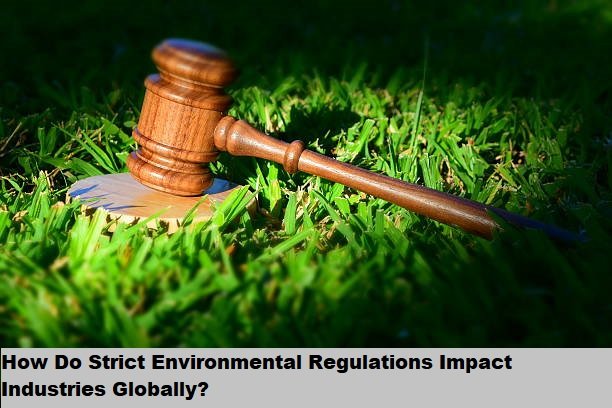Introduction:
In today’s landscape, environmental regulations wield profound influence, reshaping industries worldwide. These stringent guidelines, woven into the fabric of global economies, chart a course toward sustainability and responsible practices. Their impact transcends borders, fostering a pivotal shift in industrial paradigms. Industries navigate a maze of compliance, balancing innovation with ecological stewardship, steering toward greener methodologies. As businesses adapt, a ripple effect emerges, influencing production, resource allocation, and market dynamics. Understanding these regulations is pivotal, unlocking opportunities for innovation, fostering a symbiotic relationship between industries and the environment. This article delves into the multifaceted impact of strict environmental mandates, examining their implications on diverse sectors and the global economic tapestry.
- Economic Adaptation: Industries’ resilience and evolution under stringent regulations.
- Innovation and Technology: Influence on R&D and technological advancements.
- Global Market Dynamics: Shifts in trade, competition, and consumer behavior.
- Resource Allocation: Impact on raw materials, energy sources, and sustainability.
- Operational Compliance: Challenges and strategies for meeting regulatory standards.
- Environmental Stewardship: Industries fostering ecological balance and sustainability practices.
Economic Adaptation: Industries’ resilience and evolution under stringent regulations.
Industries, faced with stringent environmental regulations, embark on a journey of economic adaptation, showcasing their resilience and commitment to sustainability. As regulatory frameworks tighten globally, businesses must navigate a complex landscape, transforming traditional operational models. This paradigm shift often requires significant investments in research, development, and the implementation of eco-friendly technologies. The economic adaptation is evident in the restructuring of production processes, supply chains, and business strategies to align with environmentally responsible practices.
This evolution extends beyond mere compliance, as industries find innovative ways to not only meet regulatory standards but also thrive in a changing market. The economic impact is two-fold: companies that successfully adapt not only avoid penalties but also gain a competitive edge by positioning themselves as leaders in sustainable practices. Ultimately, economic adaptation becomes a catalyst for reshaping industries, fostering a symbiotic relationship between economic growth and environmental responsibility.
Innovation and Technology: Influence on R&D and technological advancements.
Strict environmental regulations stimulate a surge in innovation and technological advancements within industries. Research and development (R&D) become pivotal arenas for companies seeking to meet or exceed regulatory standards. The focus shifts towards sustainable solutions, eco-friendly processes, and the development of green technologies. This drive for innovation not only ensures compliance but also propels industries into the vanguard of sustainable practices, contributing to global efforts in combating environmental challenges.
Technological advancements play a crucial role in enhancing resource efficiency, reducing emissions, and minimizing ecological footprints. From renewable energy sources to waste reduction techniques, industries are compelled to explore and adopt cutting-edge technologies. The ripple effect extends beyond compliance, influencing market perception and consumer preferences. Companies investing in innovation not only address environmental concerns but also position themselves as leaders in a rapidly changing industrial landscape.
Global Market Dynamics: Shifts in trade, competition, and consumer behavior.
The impact of strict environmental regulations reverberates through global market dynamics, prompting significant shifts in trade patterns, competition strategies, and consumer behavior. Nations with robust environmental policies gain a competitive advantage, shaping the global trade landscape. Industries operating in regions with stringent regulations may face challenges in export and import activities, necessitating a reevaluation of international market strategies.
Competition among industries transforms, with sustainability becoming a key differentiator. Consumers increasingly prioritize eco-friendly products, driving companies to align their offerings with evolving preferences. This shift not only influences product design but also marketing and branding strategies. As a result, global market dynamics are characterized by a paradigm where environmentally conscious practices are not only a regulatory requirement but a market necessity, altering the very fabric of international trade and consumer choices.
Resource Allocation: Impact on raw materials, energy sources, and sustainability.
Strict environmental regulations reshape resource allocation strategies within industries, compelling a meticulous examination of raw materials, energy sources, and overall sustainability practices. Companies scrutinize their supply chains, seeking alternatives that reduce environmental impact. From responsibly sourced raw materials to renewable energy adoption, resource allocation strategies pivot towards minimizing ecological footprints.
Industries increasingly recognize the importance of circular economies, recycling initiatives, and sustainable sourcing to align with regulatory expectations. The impact on resource allocation extends to operational efficiency, cost management, and overall resilience. As industries prioritize sustainable practices, the allocation of resources becomes a strategic imperative, influencing not only compliance but also long-term viability and resilience in the face of environmental challenges.
Operational Compliance: Challenges and strategies for meeting regulatory standards.
The heart of the matter lies in operational compliance, where industries grapple with the challenges of meeting stringent environmental regulations. Compliance involves not only adhering to established standards but also navigating a dynamic regulatory landscape. Industries must deploy comprehensive strategies that encompass monitoring, reporting, and adapting to evolving environmental norms.
Challenges range from the financial burden of implementing new technologies to ensuring the entire workforce is aligned with environmentally conscious practices. Strategies for operational compliance involve proactive engagement with regulatory bodies, continuous improvement initiatives, and investment in employee training. Successful compliance strategies not only mitigate legal risks but also position industries as responsible corporate citizens, fostering trust among stakeholders and the broader community.
Environmental Stewardship: Industries fostering ecological balance and sustainability practices.
At the core of the impact of strict environmental regulations is the concept of environmental stewardship. Industries, driven by regulatory requirements and a growing global consciousness, are increasingly adopting roles as stewards of the environment. This goes beyond compliance and delves into a commitment to fostering ecological balance and championing sustainability practices.
Environmental stewardship involves not only reducing carbon footprints but also actively contributing to conservation efforts. Industries initiate reforestation projects, invest in wildlife preservation, and actively engage in initiatives that extend beyond their immediate operational footprint. The concept of environmental stewardship becomes a guiding principle for industries, reflecting a holistic approach to corporate responsibility that extends to the communities they operate in and the planet at large.
Conclusion:
I hope this exploration illuminates the intricate tapestry woven by strict environmental regulations on global industries. These mandates aren’t merely constraints but catalysts for transformation, steering industries toward a sustainable future. From economic adaptation to environmental stewardship, each facet underscores the profound impact and evolving nature of compliance. Industries thrive when they embrace innovation, reshaping practices to harmonize with ecological needs. The conclusion drawn is clear: the global market is reshaped by these regulations, fostering competitiveness rooted in sustainability. As resource allocation and operational compliance become strategic imperatives, the essence of environmental stewardship emerges. Ultimately, industries assume a pivotal role as stewards of our planet, navigating challenges, fostering innovation, and spearheading a collective journey towards a balanced, eco-conscious world. The trajectory set by these regulations holds promise, urging industries to forge ahead as custodians of environmental well-being.

